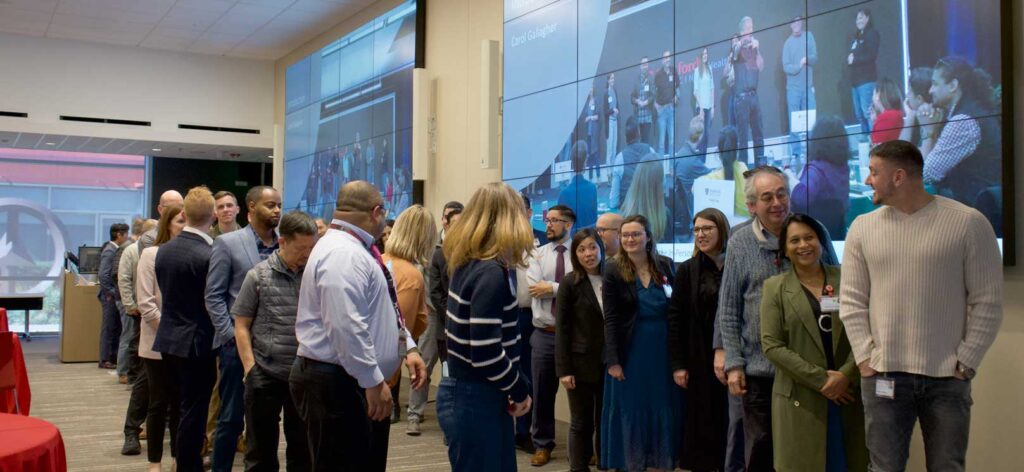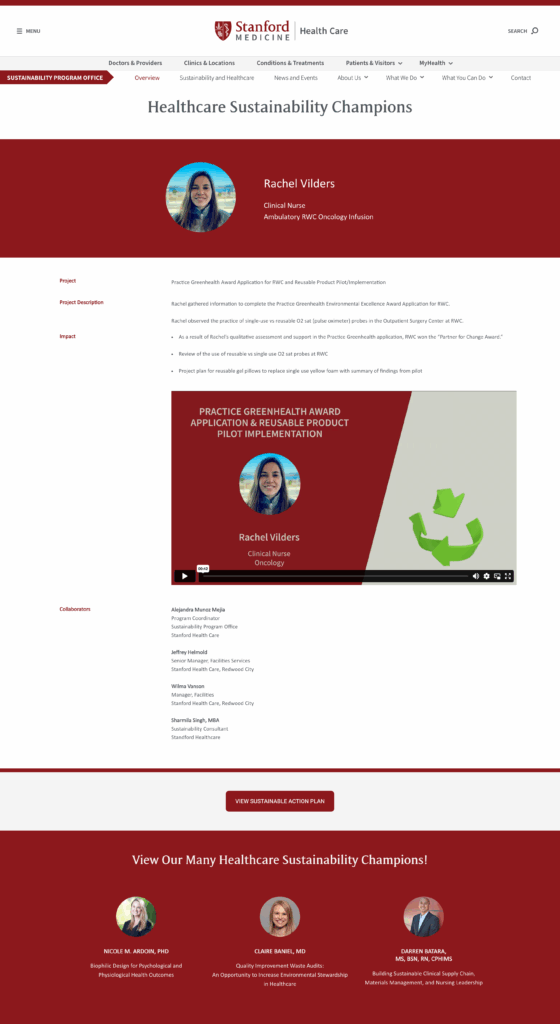
Overview
Wave Makers Group partnered with Stanford Health Care across two critical operational areas: the Infrastructure & Facilities division and the Sustainability Program Office (SPO). This collaboration went far beyond environmental goals—we supported enterprise-level change by helping teams communicate more effectively, gain internal buy-in, and execute on complex initiatives tied to both immediate needs and long-term ambitions.
From aligning executive stakeholders and securing funding, to creating high-impact internal communications and multimedia campaigns, our work helped Stanford Health Care reduce its environmental footprint, enhance operational efficiency, and improve system-wide engagement during a period of transformation. Our partnership became a model for how communications, strategy, and design can accelerate progress in both sustainability and infrastructure planning.
Challenge
Stanford Health Care needed to drive strategic change across multiple operational areas while aligning executive, staff, and public stakeholders. Key challenges included:
• Securing Resources: Communicating the value of major infrastructure and sustainability projects to leadership in order to secure budgets and board approvals.
• Executive Alignment: Translating complex technical and operational roadmaps into compelling narratives that galvanized internal stakeholders.
• Staff Engagement: Encouraging staff adoption of new practices in transportation, waste reduction, and facilities improvements.
• Cross-functional Coordination: Bringing together multiple departments—including infrastructure, sustainability, communications, and leadership—under a unified strategy.
Goal
The goals of our engagement included:
• Build internal alignment and momentum around key infrastructure and sustainability initiatives.
• Equip leaders with the right tools and messaging to secure funding and drive action.
• Reduce CO2 emissions
• Streamline transportation and facilities operations
• Improve the staff and patient experience
• Create a stronger culture of shared responsibility around long-term hospital priorities.
Approach
Our work spanned both strategic and tactical support across departments:
• Executive Messaging & Presentations: We crafted persuasive decks and narratives to help Infrastructure and Sustainability leaders secure funding, align internal stakeholders, and gain board-level buy-in.
• Internal Campaigns & Communication Strategy: Designed cross-departmental campaigns to communicate infrastructure and sustainability progress, goals, and success stories—making abstract initiatives feel tangible and inspiring.
• Content & Multimedia Creation: Produced videos, infographics, posters, and educational assets that made technical concepts more relatable, fostering broader engagement and understanding.
• Cross-Department Facilitation: Bridged silos between Facilities, SPO, and operational leaders to streamline initiatives and accelerate decision-making.
• Engagement & Behavior Change: Created gamified experiences and team-building events to encourage sustainable behavior, transportation adoption, and shared accountability.
Results
Our partnership delivered measurable impact across people, process, and performance:
• Strategic Funding & Support: Helped secure increased budgets for infrastructure and sustainability work by aligning messaging to both environmental and financial outcomes.
• Operational Improvements: Reduced energy use, CO2 emissions, and resource waste through clearer communication, employee engagement, and integrated planning.
• Internal Alignment: Enabled smoother adoption of new initiatives by aligning cross-functional teams and simplifying technical plans into digestible messaging.
• Cultural Shift: Fostered a more connected, motivated workforce that took pride in the hospital’s mission and sustainability efforts.
• Industry Recognition: Stanford earned multiple sustainability accolades, including Joint Commission and Practice Greenhealth certifications.
Conclusion
Our work with Stanford Health Care wasn’t just about going green—it was about moving forward. By helping leaders communicate more clearly, secure support, and engage their teams, we accelerated both sustainability goals and broader infrastructure initiatives. This case is a testament to what’s possible when strategy, storytelling, and execution align.
Examples of Work
LEADERSHIP STRATEGY & PRESENTATIONS:
(shown: slide covers only due to confidential information)


INTERACTIVE SUSTAINABLE JEOPARDY GAME OPEN
INTERACTIVE SUSTAINABLE JEOPARDY GAME PLAYED AT HOSPITAL
INTERACTIVE SUSTAINABLE JEOPARDY GAME PLAYED AT EARTH DAY EVENT
LEADERSHIP EVENTS:


EMPLOYEE EVENTS:


NEW EMPLOYEE ORIENTATION VIDEO (TRANSPORTATION):
HEALTH CARE SUSTAINABILITY CHAMPIONS CAMPAIGN:
HEALTH CARE SUSTAINABILITY CHAMPIONS CAMPAIGN WEBSITE



